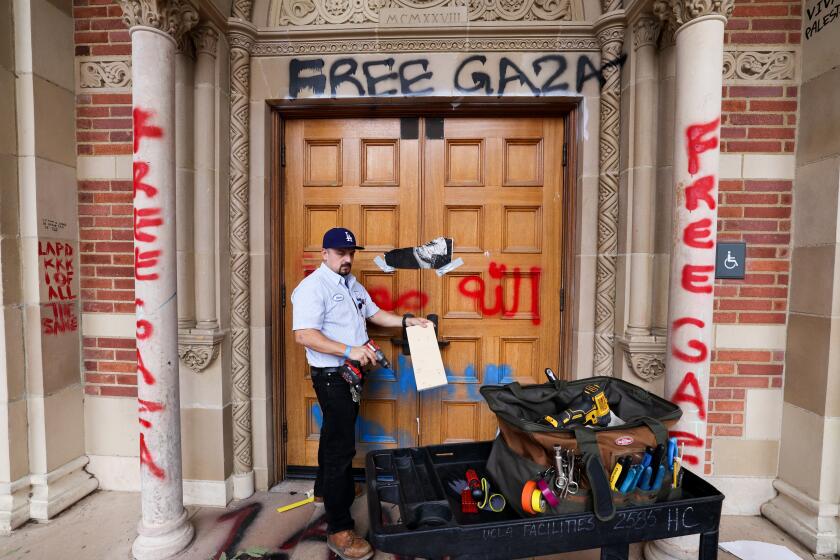Drug Tests for Entire School Weighed
Seab McDonald doesn’t care what outsiders think: He’s convinced there’s a dangerous teenage drug problem in this folksy, far-removed corner of Northern California. And the gray-haired community patriarch wants to put a stop to it now.
So McDonald and other members of the Modoc Joint Unified School District Board of Trustees are leaning toward taking a gamble they know could bring them unwanted notoriety and even lawsuits.
With the U.S. Supreme Court signaling it may soon let public schools expand drug testing beyond student athletes to include those involved in any after-school activity, Modoc officials will vote today on whether to go one step further: to test all of its 300 high school students, regardless of whether they are suspected of using drugs.
Few, if any, schools nationwide now test on such a broad scale, experts say. Those that tried backed off after legal challenges that they were violating students’ rights.
But McDonald isn’t afraid to take his place on the academic front lines of America’s debate over illicit drug use among teenagers.
“If you don’t think this community has a serious drug problem, well then you’ve got your head in the sand,” said McDonald, board president and owner of the True Value hardware store on Main Street. “Forget terrorists. Drugs are this country’s biggest enemy. We’ve got to do something.”
The plan has divided this remote ranching town of 2,900 residents between those who think “suspicionless” testing is a small price to pay and those who decry it as a government Gestapo tactic. Students complain that the entire debate demonstrates how little adults trust them to do what’s right.
Even local education officials are publicly second-guessing the school board. Said district Supt. Kevin Jolly: “I don’t want to live in a country where I can be searched without grounds just because someone suddenly decides it’s OK.”
Modoc plunged into its drug-use debate in November, when resident Angel Williams learned what she calls the truth about teenage life in Alturas, the county seat.
Her oldest son, Justin, a starting point guard for the Modoc High School Braves, confessed to his parents that he had been smoking pot for the last two years. But as Justin and his mother sat outside the school in their station wagon, waiting to pick up another of the family’s three boys, the 17-year-old senior suddenly began pointing to fellow students filing out after classes.
“Out of the blue, he began fingering different kids, saying, ‘I smoked pot with that one. I bought from that one,’ ” Williams recalled. “It was almost every student who passed by. He said, ‘Mom, you’d be surprised how many kids get high around here.’ I was just baffled. I thought, ‘This can’t be happening. Not in this small town. . . .’ ”
Williams telephoned McDonald to demand an investigation. But as officials decided what to do, other incidents unfolded.
Over the winter months, several members of Modoc High’s wrestling and basketball teams were found using and selling drugs--students who officials considered respectable role models. And last month, three Modoc High students--one the stepdaughter of a veteran Alturas police officer--were arrested after they cut class and were caught smoking pot in a car parked just outside town.
Police Chief Larry Pickett, who five years ago arrested his own stepdaughter for marijuana use while she attended Modoc High, said the Alturas drug problem is serious.
“These kids are using drugs left and right,” he said.
In recent years, Pickett said, he has seen not only marijuana use but methamphetamine and cocaine use as well. “This really concerns me,” he said. “We don’t know where this is leading.”
9,500 Residents in County
Bordering Oregon and Nevada, Modoc County is so secluded, school officials say, that it has become a frequent home for families involved in the federal government’s witness protection program.
With 4,500 square miles--an area larger than Los Angeles County--Modoc County is home to a mere 9,500 residents-- and just one four-way stoplight. After Alturas, the next biggest town--100 miles away--has 300 people. Consisting of 70% federal and state forest land, the county has no malls, no commercial flight service and one weekly newspaper. It was the only one of California’s 58 counties to lose population in the last census.
Across the nation, student drug use has been gradually rising in recent years, according to a University of Michigan study. But the trend has grown faster in rural areas.
Drug use among Modoc County teenagers seems typical of other small places, experts say. In a 1998 survey of 712 county kindergarten through 12th-grade students, 28% admitted using marijuana at least once in the previous year. Six percent said they had used methamphetamine at least one time.
But whether Modoc’s numbers fit national averages is immaterial, local officials say.
“We may have more of a drug problem than the community down the road or less of one--that really doesn’t matter to us,” said Supt. Jolly. “Whatever it is, we think our problem needs addressing. The question is how to do it.”
Students call the plan an over-reaction, saying their own drug-use survey found that less than 10% of students had ever come to school under the influence.
It was in 1998 that Angel Williams and her husband moved to Alturas from Dallas to help their sons escape big city bad habits.
They opened a Texaco station, with the boys helping out on nights and weekends. But then Justin seemed to change. He stopped work at the station and spent time in his room or at a friend’s house.
“He didn’t socialize with us--we were suddenly taboo,” his mother said. “We figured a burg like this would be problem-free. Boy, were we delusional.”
Williams said she heartily supports random testing of every Modoc High student.
At the Main Street coffee shop, opinions about the town’s teenagers come fast and furious.
“I don’t think these students ought to be trusted--they’re just kids,” said Shirley Clay. “If they don’t do drugs, then they’ve got nothing to worry about.”
Rancher John Gilstrap agrees.
“Kids always give you a lot of lip about things you tell them to do and then come back years later and tell you it wasn’t so bad after all,” he said.
Local teenagers blame their disaffection on plain restlessness.
Alturas has no video arcade or even a bowling alley, and the single-screen Niles Theater only opens on weekends. The result: There’s not much else to do for fun other than get high, some children say.
“I was bored out of my mind when I was in high school here,” said Alturas waitress Kati Snavely, now 22. “After school, my friends came to my house and we watched movies and got stoned. And I still managed to be an honor student.”
Carrie Anderson, who taught school here for 37 years, has an answer to that: “We know we’re isolated hicks from the sticks and we wouldn’t want it any other way. My husband used to say, ‘If these kids are bored, there’s a nice library right here in town. . . .’ ”
Recently, 170 people packed a school board meeting to protest the drug-testing plan. Many said the tests would cost money that would take away from academic expenses. Others complained that the plan violates their 4th Amendment right against unlawful search and seizure.
Court Ruling Expected
Dismissing the uproar, McDonald claims he is supported by the town’s “silent majority.”
“I didn’t realize the 4th Amendment gives kids the right to do illegal things,” he said.
In 1995, the U.S. Supreme Court upheld the testing of high school athletes based on a case in Oregon. Since 1998, 5% of schools nationwide have performed drug tests on student athletes and an additional 2% on students enrolled in other after-school activities, studies show.
The case now before the high court involves an Oklahoma high school that tested all students who took part in after-school activities. A student in the school choir filed suit, complaining that the test constituted an unreasonable search. But in oral arguments last month, the justices seemed to side with the school and signaled they might even approve wider testing. A ruling is expected this summer.
Modoc High’s current policy allows for drug testing only when officials have cause to suspect a student. Under the new proposal, every student would be tested at the start of the school year. After that, 10 would be randomly selected each month for retesting. Those with positive results would receive counseling, their parents would be notified and, if problems continued, they would lose privileges to after-school programs. They would not be subject to arrest, however.
The Modoc Joint Unified School District board--whose members include a truck driver, teacher and retired beer distributor--is leaning 3 to 2 in favor of school-wide testing, with McDonald being the plan’s most vocal proponent, officials say.
Others, however, urge caution.
Until the courts legalize such broad-based tests, approving the plan will place them in “unexplored territory” and leave them open to lawsuits, some officials say. Said Modoc High Principal John Nickel: “It’s not the kind of notoriety our school is looking for.”
Activists warn that they will sue schools that try to test all students.
“This invades people’s privacy in just about every way you can think of,” said Ann Brick, an ACLU attorney in San Francisco. “Students may be taking birth control pills, which they can legally do without parental consent, or be on depression medication--all extremely personal information they’d have to divulge in a drug test.”
Modoc High graduate Snavely said parents are two-faced to point fingers at their children. “Everybody’s an alcoholic in this town,” she said. “But they preach to us about drugs.”
Officials acknowledge that Alturas has endured a wild past. A former railroad and logging center, the town once had 17 bars and just two churches--and got nationwide attention as America’s per-capita leader in the consumption of Early Times bourbon.
Nowadays, Alturas has only a handful of bars and 18 churches, yet runs two Alcoholics Anonymous programs.
Other Efforts Cited
McDonald growled after one student suggested that the entire town take drug and alcohol tests. “That’s the most ridiculous thing I’ve ever heard,” he said. “But if they want, I’ll be the first to take the test.”
To support his plan, McDonald points to similar measures elsewhere, like the Florida private academy that administers Breathalyzer tests at dances and the Texas public school that tested students and teachers before a local judge ruled the practice was illegal.
“Those tests worked,” said Raymond Lusk, superintendent of schools in Lockney, Texas. “After we started, drug use stopped cold.”
McDonald said it’s time the adults in Alturas take charge of their community.
“My kids didn’t have rights until they turned 18--I had control,” said the 59-year-old, whose two grown daughters attended Modoc High. “When you’re 21, OK. Until then, go to court and get emancipated if you want freedom.”
As he sits in his cramped hardware store office, McDonald’s voice chokes as he divulges another motivation behind his plan. One of his daughters suffers a drug habit that he acknowledges began at Modoc High, right under her father’s nose.
“I hope to God she’s clean now,” McDonald said, sobbing. “When she was in high school, she hid the signs from me. I didn’t know. But I see the same signs in these kids today and it just hits too close to home.”
More to Read
Start your day right
Sign up for Essential California for news, features and recommendations from the L.A. Times and beyond in your inbox six days a week.
You may occasionally receive promotional content from the Los Angeles Times.







